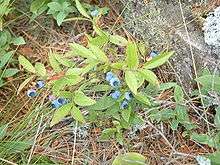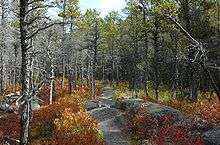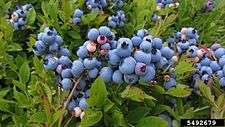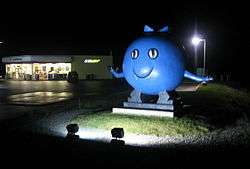Vaccinium angustifolium
Vaccinium angustifolium, commonly known as the wild lowbush blueberry, is a species of blueberry native to eastern and central Canada (from Manitoba to Newfoundland) and the northeastern United States, growing as far south as the Great Smoky Mountains and west to the Great Lakes region.[3][4]
| Lowbush blueberry | |
|---|---|
 | |
| Pancake Bay Provincial Park, Ontario | |
| Scientific classification | |
| Kingdom: | |
| (unranked): | |
| (unranked): | |
| (unranked): | |
| Order: | |
| Family: | |
| Genus: | |
| Species: | V. angustifolium |
| Binomial name | |
| Vaccinium angustifolium | |
| Synonyms[2] | |
| |
Etymology
The species epithet angustifolium is a combination of the Latin words angustum meaning 'narrow', and folium meaning 'leaf'. It shares this epithet with other species of plants including Epilobium angustifolium.
Description

Vaccinium angustifolium is a low spreading deciduous shrub growing 5 to 60 cm (2 to 24 in) tall.[5] Its rhizomes can lay dormant up to 100 years, and when given the adequate amount of sun light, soil moisture and oxygen content they will sprout. The leaves are glossy blue-green in summer, turning a variety of reds in the fall. The leaf shape is broad to elliptical. Buds are brownish red in stem axils. The flowers are white, bell-shaped, 4 to 6 mm (0.16 to 0.24 in) long. The fruit is a small sweet dark blue to black berry, full of antioxidants and flavonoids. This plant grows best in wooded areas, old abandoned farmyards or open areas with well-drained acidic soils. In some areas it produces natural blueberry barrens, where it is practically the only species covering large areas.[6]
There may be several buds on a healthy stem and each bud can open up and have several blossoms. A blueberry field that has full plant coverage can have as many as 150 million blossoms per acre.
The Vaccinium angustifolium plant is fire-tolerant and its numbers often increase in an area following a forest fire. Traditionally, blueberry growers burn their fields every few years to get rid of shrubs and fertilize the soil. In Acadian French, a blueberry field is known as a brûlis (from brûlé 'burnt') because of that technique, which is still in use.
Distribution and habitat
The lowbush blueberry is native to Canada, Maine, and Massachusetts and also grown commercially there, mainly harvested from managed wild patches. It is also a favorite of recreational berry pickers, black bears, coyotes, racoons, foxes, porcupines, white-tailed deer and birds. To help keep the unwanted individuals out of the blueberry fields and from damaging or eating the crop growers will fence their fields and connect power or use an automated surround sound speaker system called a bird squawker. This bird squawker is set up on a timer system to send out predator bird sounds during the day and at night the system can be programmed to discourage night time crop feeders.
While eating blueberries black bears roll around and damage the surrounding crop. They forage on the berries from daylight to dark.
Its leaves are also popular among caterpillars. It is a larval host to the pale tiger moth, the peppered moth,[7] the chain-dotted geometer, the saw-wing moth, the blueberry gray moth, the mousy angle moth,[8] Caloptilia vacciniella, Andromeda underwing, the shadowy arches, the two-spot dart,[9] the dingy cutworm moth, the speckled cutworm,[10] the decorated owlet, the pirate looper, Norman's dart, the gray swordgrass moth, the pink-edged sulphur butterfly, the pawpaw sphinx moth, and the blueberry leaftier moth.
Pollination
During the harvest year blueberry growers rent honey bee hives to put in their fields for pollination. These hives are placed in the fields at a density range of anywhere from 1-8 hives per acre. The hives are placed in the fields at 10-20% bloom allowing the bees to have enough forage in the field rather than going elsewhere to forage. Hives are left in blueberry fields for 2 weeks on average, allowing the bees to pollinate the variety of clones in the field, all of which bloom at different times during the two-week period.
Some growers also use bumble bees as well in hopes of maximum pollination. Bumble bees will fly in colder and wetter weather conditions than the honey bee will, and they also pollinate in a different way then the honey bee. Bumble bees are able to sonicate the flowers, which releases pollen from deep inside the poricidal anthers. This is known as buzz-pollination.
Blueberry growers also rely on many wild bees for pollination, including solitary bees like Andrena carlini and Colletes inaequalis.[11]
Production
In 2006, production of wild blueberries in Quebec has reached 70 million pounds (31.8 million kg). From this, 55 million pounds (2.2 million kg) were produced from the specially equipped blueberry farm (bleuetière), and 15 million pounds (6.8 kg) were collected in the forest. The vast majority of blueberries, or 67.5 million pounds (30.7 million kg), has been marketed under various processed forms, and particularly in the form of frozen wild blueberries. In 2016, the production of wild blueberries was the highest ever in Quebec reaching 115 million pounds. The production reached 60 million pounds in Nova Scotia in 2016. The plant's rough acreage in Nova Scotia is 46 thousand.
The wild blueberry is the number 1 fruit crop in acreage export sales, and value. Nova Scotia's provincial production has hit over 60 million pounds.
Harvesting of wild blueberries begins in August and continues until late September.
Pruning
Native Americans regularly burned away trees and shrubs in parts of eastern Maine in order to stimulate blueberry production. Modern farmers use various methods of burning or mowing to accomplish this.[12] There are a number of methods growers use to stimulate blueberry production on their land, such as burning the land or using a flail mower, bush hog, lawn mower, etc. to cut the plants off as close to the ground as possible without scalping the land. These procedures are used to promote the spreading of rhizomes under the soil. Some growers use a sickle bar mower in the fall after the crop has been harvested to mow the plants off, leaving roughly 1 to 2 inches of stem so the growers can then burn the remainder of the plants in the spring, using less fuel for the fire.
Products
.jpg)
Roughly 90% of wild low bush blueberries are sold IQF (Individual Quick Frozen). Some berries are fresh packed during harvest season and sold at farm markets and grocery stores. There is 100% pure wild blueberry juice on the market. The fruit can be used to make a wide variety of food products such as blueberry smoothies, a blueberry sauce for waffles, blueberry grunt, blueberry lemon loaf, blueberry crisp, blueberry muffins, blueberry jam, blueberry martinis, and can be used for a topping on cereal or yogurt.
Nova Scotia wild blueberries are exported to the United States, Japan, Germany, United Kingdom and other countries.
Nutrition
Wild blueberries are a good source of Vitamin C and dietary fiber. They contain no fat, sodium or cholesterol and are only 80 calories per cup of berries. Recent studies have shown that the pigments in the skin of the berries can provide health benefits to the consumer. These pigments are called anthocyanins which contain antioxidants. The antioxidants in the berry help to fight compounds called free radicals which can cause cancer, heart disease, other diseases and premature aging. In a study by the USDA wild blueberries were found to have the highest level of antioxidants out of 40 fruits and vegetables.
In a study conducted by the USDA it has been shown that wild blueberries may help fight the effects of aging. The antioxidants found in the skin of the wild blueberries help the skin to maintain elasticity over time.
Tannins, which are found in wild blueberries and cranberries, can prevent the bacteria that cause urinary tract infections from attaching to the wall of the bladder and urinary tract, thus allowing them to pass through the body without causing any harm.

State fruits

The lowbush blueberry is the state fruit of Maine and the wild low bush blueberry is also the Nova Scotian Provincial Berry. Oxford, Nova Scotia is nicknamed "Wild Blueberry Capital of Canada".
References
- "Vaccinium angustifolium". Tropicos. Missouri Botanical Garden.
- "Vaccinium angustifolium". World Checklist of Selected Plant Families (WCSP). Royal Botanic Gardens, Kew – via The Plant List.
- "Vaccinium angustifolium". Natural Resources Conservation Service PLANTS Database. USDA. Retrieved 2013-08-04.
- "Vaccinium angustifolium". County-level distribution map from the North American Plant Atlas (NAPA). Biota of North America Program (BONAP). 2014.
- Tirmenstein, D. A. (1991). "Vaccinium angustifolium". Fire Effects Information System (FEIS). US Department of Agriculture (USDA), Forest Service (USFS), Rocky Mountain Research Station, Fire Sciences Laboratory – via https://www.feis-crs.org/feis/.
- Vander Kloet, Sam P. (2009). "Vaccinium angustifolium". In Flora of North America Editorial Committee (ed.). Flora of North America North of Mexico (FNA). 8. New York and Oxford – via eFloras.org, Missouri Botanical Garden, St. Louis, MO & Harvard University Herbaria, Cambridge, MA.
- https://bugguide.net/node/view/19107
- https://bugguide.net/node/view/554947
- https://bugguide.net/node/view/22844
- https://bugguide.net/node/view/43460
- Bushmann, Sara L.; Drummond, Francis A. (August 2015). "Abundance and Diversity of Wild Bees (Hymenoptera: Apoidea) Found in Lowbush Blueberry Growing Regions of Downeast Maine". Environmental Entomology. 44 (4): 975–989. doi:10.1093/ee/nvv082. ISSN 1938-2936. PMID 26314043.
- "The University of Maine - Cooperative Extension: Maine Wild Blueberries - 229-Pruning Lowbush Blueberry Fields". Umaine.edu. 1914-06-30. Retrieved 2013-08-04.
